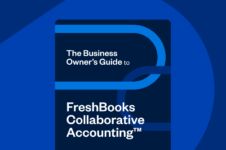If you’re like many small business owners, the mere mention “accounting” or “finances” makes you want to run for the hills. But there are many accounting tasks you can easily manage yourself!

The challenges you face as a small business owner are vast. Not only do you have limited resources, time, and money, but there’s a lot to do. You have to manage many different functions such as HR, sales, marketing and customer service.
But, one of the biggest challenges is managing your finances. The reality, though, is that managing finances isn’t complicated and doesn’t have to cost a fortune.
In fact, there are five accounting tasks you can master with the help of online software. Learn how to do these tasks, and you’ll have learned the fundamentals. In the process, you’ll also save money as you don’t have to outsource the tasks to a trusted advisor.
Accounting Task #1: Staying on Top of Invoicing
While you can stay on top of your invoicing in Excel, there’s one problem: you open yourself up to some common invoicing mistakes such as incorrect dates and invoice numbers. Not to mention the back and forth between clients in fixing the errors, and the ultimate delays in payment.
The solution? Use automated online invoicing systems. For instance, FreshBooks updates the invoice numbers automatically and allows you to preview invoices before sending them.
What’s more, you can track how much time you spend working on client projects and create invoices directly from there. You can also:
- Create customizable invoices for each client. For example, you can alter the currency according to client needs.
- Accepts up front deposits before starting work.
- Manage outstanding payments by setting automated payment reminders when an invoice becomes overdue.
- Save time by duplicating past invoices that are similar to current ones.
- Apply sales tax per invoice and prepare yourself for filing your tax return (more on that later).
But, simplifying your invoice process is one thing. You also need to ensure you’re making it easy for clients to pay and that you’re recording all invoice payments.
Accounting Task #2: Accepting & Recording Invoice Payments
There’s nothing more gratifying than receiving a payment and watching your bank balance grow. I know it’s one of my favorite parts of my job as a freelance writer.
While rewarding, managing and recording invoice payments can become an administrative nightmare. You need to track who has paid you, how they paid you, whether the bank cleared the payment, whether it was on time, the month the payment cleared and so the list goes on.
On top of that, you’re probably also running to your bank, depositing cheques, dealing with bounced payments, and managing foreign currency exchanges.
It becomes increasingly difficult to manage the above, as your business grows. And that’s not to mention the difficulty in recording payments if you’re updating spreadsheets.
Thankfully, accepting and recording invoice payments is a breeze with the right software. Consider how easily you can accept and record payments with FreshBooks.
Learn how to do these tasks, and you’ll have learned the fundamentals. In the process, you’ll also save money as you don’t have to outsource the tasks to a trusted advisor.
Accepting Payments
Accept online payments directly from your invoice by integrating your credit card. Not only will it make paying convenient for your client, but it will also speed up the payment process. Simply connect your FreshBooks account to FreshBooks Payments to accept payment from Visa, Mastercard, and Amex.
Recording Payments
FreshBooks automatically records all invoices under one roof. Your books will be up to date without you having to lift a finger. Furthermore, with the unique reporting features, you get a detailed history of all the invoices you’ve ever sent.
Accounting Task #3: Managing Billable and Non-Billable Expenses
Beyond invoicing, you also need to track expenses, which is one of the most significant accounting activities. But why?
Tracking expenses allows you to monitor business growth, build financial statements, track tax deductibles, and prepare tax returns.
Manage your expenses with the help of FreshBooks by simply connecting your credit card or bank account. FreshBooks will update your expenses automatically each day.
With the right tool you can also:
- Snap a picture of a receipt, log it and store it in the cloud.
- Categorize expenses to help when preparing tax returns.
- Access expense reports to keep your spending in check.
- Mark expenses as billable, add a markup and pull them into an invoice for a client.
Bonus Tip
As a small business owner and someone who’s about to file a tax return, one of my biggest challenges has been getting to grips with tax deductibles. Below are some tax deductibles to keep in mind when preparing your tax returns:
- Meals and entertainment: business meetings in a coffee shop.
- Out of town business travel: travel for business purposes.
- Vehicle-related expenses: any vehicle used for business purposes.
- Home office receipts: percentage of your home you use for business
- Internet and cell phone: data and business related calls.
Accounting Task #4: Tracking Sales Tax
If you’re collecting sales tax and not tracking it, you risk combining it with your profit and spending. The result? You fall short when it comes to paying tax. I’m sure you’d rather avoid a situation where you don’t have money to pay the tax man.
Using a single tool for all your invoicing and accounting provides an “at-a-glance” summary of the tax you’ve collected for all invoices. You’ll remain in control of your tax by knowing how much money to set aside. Come tax time, you’ll feel confident that all is in order.
Accounting Task #5: Knowing Where Your Business Stands
Running a successful business is so much more than sending invoices, collecting payments, tracking expenses and filing tax returns.
It’s about knowing where your business stands. Knowing how much cash is coming in and leaving your business. Knowing how much profit you’ve made at the end of the month.
While you probably recognize this, it’s easy to get caught up in the day-to-day operations and forget about it. It’s easy to see every payment as a profit, and not factor in expenses like rent, equipment, stationery, hardware, and so on. It’s also easy to wait until month end only to discover that you’re out of pocket because clients haven’t paid you.
Before you know it, you’re struggling.
The solution is to stay on top of the money flowing in and out of your business so that you know how much profit you’re making.
Use software that provides financial reports on the health of your business. For example, FreshBooks’s reporting features provide the following benefits and features:
- Immediately know your business health with a summary of profit and outstanding revenue that you need to collect.
- Understand how profitable you are with profit and loss reports which document your income and expenses.
Managing these five accounting tasks is a breeze when you use the right tool. By learning how to do these tasks yourself, you’ll have nailed the fundamentals of managing your finances.
When you eventually decide to turn to a trusted advisor – like an accountant or bank manager—you’ll have clear breakdowns and customizable reports that are easily accessible and downloadable.

Written by Nick Darlington, Freelance Contributor
Posted on August 4, 2017







